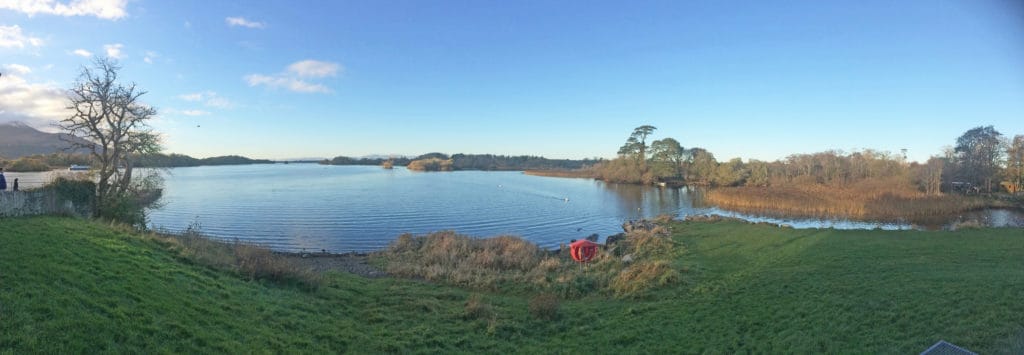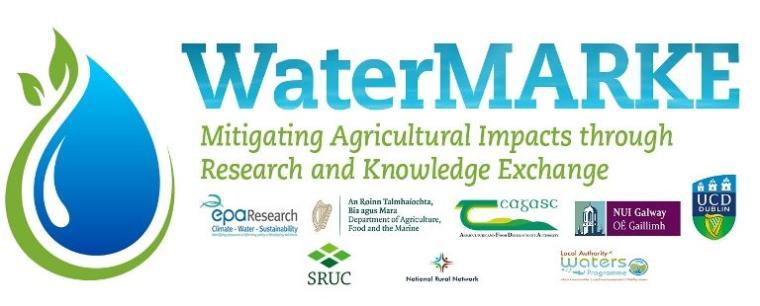Water – Mitigating Agricultural impacts through Research and Knowledge Exchange

Context
The WaterMARKE project was initiated in response to the need for the intensification of agriculture to be sustainable, dealing specifically with the issue of water quality. It is jointly funded by the Environmental Protection Agency (EPA) and Department of Agriculture, Food and the Marine (DAFM). The EPA Research Programme is a Government of Ireland initiative funded by the Department of Communications, Climate Action and Environment. Working closely with the Agricultural Sustainability Support Advisers (ASSAP) who are providing advice and support to farms in areas where there are water quality issues, the WaterMARKE research team aims to develop tools for water quality risk assessment and the selection of appropriate water quality protection measures.
Summary
As the name of the project suggests, it is based around research and knowledge exchange. The research team is made up of biophysical scientists, economists, behavioural psychologists and extension/advisory experts. The project uses research to build an evidence base that shapes the tools developed. The knowledge exchange component of the project involves researchers, farmers and advisers in the co-design of a water quality risk assessment process, as well as the selection and design of measures that are appropriate for the level of risk, the water quality in the area and the soils, farm system and intensity of farming. Importantly the project recognises that the same measures don’t work on all types of farms and that a tailored approach is needed.
The biophysical scientists are focusing on using the ‘right measure’ at the ‘right time’ in ‘the right place’ for different levels of risk of loss of nutrients to water. The project also goes beyond just focusing on risk assessment and works on practical water quality measures to look at how policy makers, agri-food co-ops, consultants, contractors and communities can all influence positive water quality outcomes. WaterMARKE takes a comprehensive approach to a complex problem of major importance to farm and agricultural sustainability.
Context
Supporting farm viability goes beyond economic concerns. It is increasingly complex with multiple drivers. The ‘sustainable intensification’ of agriculture approach is a method gaining increasing attention offering potential not just to support enhanced farm viability, but to do so in a more holistic way, bringing economic and environmental benefits. For example, a guiding principle of FoodWise 2025, DAFM’s ten-year plan for the agri-food sector, is that environmental protection and economic competiveness are equal and complementary. One will not be achieved at the expense of the other to achieve industry growth targets.
Sustainable intensification works to produce more output from the same land area but also reducing negative environmental impacts. Alongside this, despite recent policy developments working to protect water quality, surface and ground water quality remains an environmental concern for agriculture. For example, measures have been introduced to keep nutrients such as phosphorus and nitrogen on farmland but while surface water quality had stabilised, it has begun to decline again in recent years. Therefore, measures are needed to improve water quality where it is unsatisfactory.
The WaterMARKE project emerges in this context in response to the need for evidence-based tools to help ensure that the intensification of agriculture is sustainable and protect water quality. It also recognises the complexity of achieving good water quality as part of sustainable agriculture, which is reflected in the project activities and the expertise it brings together.
“The WaterMARKE project approaches the issue of water quality from the scientific, institutional, behavioural and knowledge exchange perspectives.” – Dr. Mary Ryan, WaterMARKE Project Coordinator with Teagasc
A diverse range of partner organisations who share the concerns that WaterMARKE sets out to address have come together to deliver the project. The project is coordinated by Teagasc, with partners in National University of Ireland Galway, University College Dublin, the Local Authority Waters and Communities Office, the National Rural Network (NRN) and Scotland’s Rural College, Edinburgh. It is co-funded by the EPA and DAFM.
Objectives
The WaterMARKE project will develop operational guidelines for farmers, advisors and policy makers for the successful implementation of risk assessment water quality measures at farm scale. An underpinning objective is to identify ‘win-win’ measures where economic (e.g. farm incomes) and environmental (e.g. improved water quality) outcomes do not come into conflict, with water quality improved on farms with the lowest cost. It will:
- Develop a farm-scale risk assessment to select measures for water quality protection
- Identify barriers to adoption of water quality protection measures
- Using the ‘right measure, right place, right time’ approach to design a knowledge exchange template for water quality protection measures
- Evaluate options to scale up the implementation of water quality protection measures beyond the pilot case study farms
- At a national scale, the project examines the roles and interactions of all the actors (institutions) involved in the agri-food production value chain, in order to examine how the information flows and the structure of future programmes could be improved to facilitate further sustainable development and intensification of Irish agriculture.
Activities
- Water quality risk assessment and knowledge exchange framework
WaterMARKE will develop a farm-scale risk assessment to select measures for water quality protection that can be used by farmers and advisors. Measures selected will be locally relevant to each pilot farm. This will be carried out using a co-design and co-learning process. For example, farmers and farm advisors will help to develop and refine the risk assessment template. Another important part of WaterMARKE’s work is to assess the causes of positive and negative actions that influence water quality on farms, as well as identifying potential ways to influence these behaviours.
“Firstly, the project co-designs risk assessment and mitigation measures in conjunction with farmers on the basis of biophysical, economic cost, transaction cost and farmer behaviour perspectives, before trialling these measures at a wider scale to develop and refine a knowledge exchange template. The project also provides options for scaling up the implementation of proposed measures, based on expert opinion” – Dr. Mary Ryan, WaterMARKE Project Coordinator with Teagasc
WaterMARKE will develop a knowledge exchange framework to build awareness of water quality risks, as well as knowledge and acceptance by farmers of water quality protection measures available to them. Focus is placed on locally tailored options that are ‘win-win’ from economic and environmental perspectives.
Assessment of the potential to scale up the WaterMARKE tools will also be carried out looking at the cost of implementation relative to benefits.
- Institutional analysis
A range of players are part of the institutional framework concerned with improving water quality. These include farmers, advisers, specialists, researchers, policy makers, regulators, local authorities and local communities. Another aspect of WaterMARKE involves developing a shared understanding of problems and solutions at the different levels these actors work, as well as changes needed to overcome these. A case study of the Burren Programme, which is focussed on biodiversity outcomes, is also being undertaken. Analysis will identify lessons that are transferable to water quality issues, such as key incentives and drivers, based on how this project improved ecological conservation in the Burren Uplands.
Results
- WaterMARKE will develop a water quality risk assessment tool. This can be used by farmers and advisors to identify areas on farms where measures for mitigating nutrient and sediment losses to water could be implemented.
- The knowledge transfer template will provide a practical tool to support implementation of water quality protection measures. It will be tested and refined, implementing key lessons and learning across the project. This includes roll-out to demonstration farms using the Teagasc advisory service.
- The institutional analysis will identify options on how administrative, operational, practical and behavioural barriers to implementation can be overcome at national, regional and farm scales. Options may include proposals for changes around regulation, financial incentives and training.
- More broadly, the evidence emerging from WaterMARKE will be valuable to researchers and policy-makers in relation to water quality and sustainable intensification.
Further Information
For more details on the project and project partners visit: https://www.teagasc.ie/watermarke/
Follow WaterMARKE on Twitter: @WaterMarke
National Rural Network WaterMARKE Leaflet
Download the National Rural Network’s WaterMARKE Project case study leaflet here.

DISCLAIMER: Although every effort has been made to ensure the accuracy of the material contained in this NRN case study leaflet, complete accuracy cannot be guaranteed. Neither the Environmental Protection Agency nor the authors accept any responsibility whatsoever for loss or damage occasioned or claimed to have been occasioned, in part or in full, as a consequence of any person acting or refraining from acting, as a result of a matter contained in this NRN case study leaflet.

